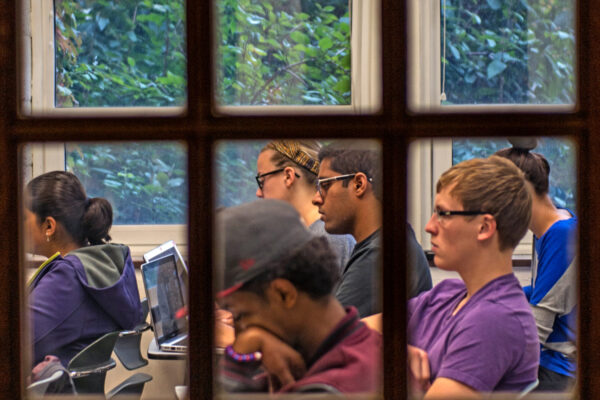By Noelle Witherspoon Arnold
The National Center for Institutional Diversity at the University of Michigan interviewed a number of academic diversity officers (ADOs) to learn more about how they view their role. Results from this study were published last fall. In this new blog series, ADOs and other senior leaders discuss the role, the challenges ADOs face, and the opportunities these positions bring to college and university campuses.
Increasing the enrollment of groups historically excluded in higher education has created a challenge both for those in power and those of us tasked with creating diversity in higher education. On the one hand, it assumes that the presence of these marginalized groups signals that we are including who historically have been marginalized. On the other hand, it does not mean that structures and policies have become more welcoming, open, or accessible. Recognizing this circumstance should move us to consider what happens when these students operate in spaces ill prepared and unreserved for them.
At its most basic definition, diversity is the “condition of having or being composed of differing elements.” To follow this definition alone, you could argue that colleges and universities are diverse. However, inclusivity is not quite the same as “dealing with” diverse groups. Many diversity officers find themselves working on campuses that still mistake quotas, tokenism, erasure, and assimilationist practices as inclusion.
Traditional discourses regarding identities, difference, and success inform how colleges and universities create strategies that only scratch the surface in creating more inclusive campuses. Adjustments or accommodations for inclusion only reinforce structures that highlight the marginalization of those for whom these inclusion efforts are meant to target. We must also clarify what inclusive leadership means, and work to develop structures of support that foster inclusive leadership mindsets and practice.
An emerging framework for inclusive leadership at the College of Education and Human Ecology (EHE) at The Ohio State University offers some examples of how our institution is putting the frame to work.
Emerging Framework for Inclusive Leadership
My Emerging Framework for Inclusive Leadership, which will be included in the forthcoming Encyclopedia of Educational Administration, focuses on place, preparation, and practice as domains that help leaders cultivate an inclusive culture that encourages relationships among other people, communities, and society at large. These three domains each play a role in supporting inclusive leadership mindsets and practice. The ultimate goal is that this framework can be scaled beyond leadership development to larger transformative practices, policies, and activities.

Figure 1: Emerging Framework for Inclusive Leadership (Arnold, forthcoming)
Place
One of the things we know is that leaders do not simply manage the organizations in which they lead. The leadership sphere represents one that includes contexts such as the communities inside and outside the organization. “Leadership of place” is an inclusive model of leadership, based on the understanding that leaders must build inclusive cultures and contexts. For leaders, this means not only technical, managerial leadership, but also building more inclusive spaces. Inclusive leaders also coordinate across real and imagined boundaries and reconcile the interests and understanding of a range of individuals, institutions, communities of place and practice.
As a part of our initiative on urban and rural ecologies, EHE recently signed an MOU with the Columbus Urban League (CUL). The MOU provides a concrete plan for EHE’s integration in the community, such as establishing EHE offices in CUL’s building in Columbus’s historic Near East Side community and conducting EHE classes onsite. One goal of these activities is to work with the community to facilitate pathways to college. The MOU also outlines EHE services to CUL and the community such as free EHE-led evaluations of CUL programs, assistance with community events, and input in strategic planning. Rather than simply conducting research in the community, we want to become co-leaders with the residents and businesses to support the neighborhood. The EHE Office of Equity, Diversity, and Global Engagement partners with the campus service-learning office to match funds for instructors to create service learning and community engagement courses that serve underserved communities. Each faculty member will receive an initial matching grant to develop the course and an eligible grant to assist with sustainability plans for continuing service in the community.
Preparation
Those who work in higher education must be trained to identify inequalities as they exist within institutions, to think beyond what exists to what could be, and to overcome inequalities as they transform organizations to be inclusive places. Leadership development involves building capacity, authenticity, and expertise in varying aspects of leadership. According to research by Young and colleagues, programs should prepare “leaders for the systems in which they will work, while also developing their ability to rethink, reimagine, and transcend those systems.”
For example, many faculty pipeline programs exist to increase the number of underrepresented faculty. However, these programs often only add one or two faculty at a time, which can perpetuate isolation and further marginalization among these faculty members. The EHE Dean’s Diversity Postdoctoral Fellows Program (PFP) is a cohort program that takes an intentional approach to enhance recruitment and the faculty pipeline with the intent to hire PFP scholars after the two-year postdoctoral appointment. During their two-year appointment, scholars work on their own research agenda with intensive support, including bimonthly professional development; a paid mentoring team; and research, teaching, and service requirements related to their research agenda.
Practice
Inclusive leadership practice involves cultivating dispositions that support inclusion, advocating for and cultivating inclusive and culturally responsive practices and behaviors. Indeed, we believe that inclusive leaders’ greatest potential for practice lies in the interaction between the conversations they foster, the narratives they shape, the opportunities they afford, and the educational climate they seek to create. As such, leaders’ work in this area must be grounded in a commitment to understanding and creating new knowledge about diversity, inclusive practice, and to fostering social relations across differences.
The EHE Historically Underrepresented Ethnicities Success (HUES) program is a student recruitment and success program in the Office of Equity, Diversity and Global Engagement (EDGE) that serves students of diverse racial, ethnic, and cultural backgrounds. Some of the activities in HUES include the EDGE-Y Teaching and Learning Retreat, which provides opportunities to engage in and develop teaching and advising practices to create inclusive environments and practices for students. Participation is incentivized and faculty receive year-long assistance to build their syllabus, procure resources, and training in difficult dialogues.
Another effort is EHE Early Connect (HUES-EEE). HUES-EEE is a pre-freshman summer orientation activity designed to offer supplemental support to help students make a successful transition from high school to college. Participating students work with faculty and staff to learn about the resources and funding available to them as they navigate coursework and college life, professional norms in education careers, and college and university activities and networks, and meet faculty and staff of color. In addition, HUES-EEE participants engage in roundtable discussions with department chairs and college leadership around their needs and expectations.
Dignity
Many in higher education live, learn, and work in spaces in which they experience multiple assaults to their sense of dignity. Dignity is essential to authentic inclusion. Research by Irby and Drame asserts that intentional efforts must be made “to understand and eliminate all subjective experiences and conditions of oppression, humiliation, and degradation.”
Although inherent dignity is inviolable and cannot be stripped, a person’s sense of dignity can. In developing inclusive cultures, leaders must address forces that dehumanize at personal, systemic, and institutional levels. EHE is currently working on a dignity framework to assess systems, policies, practices, and languages to ensure dignity, full inclusion, and access, particularly for persons who identify as members of historically disenfranchised groups.
These examples are but a few ways to move beyond naming inclusive leadership and articulating it in creating purposeful inclusion by being deeply mindful and intentional. The inclusive leader works to support others’ identities, fosters understanding, respect, and dignity, and works to build a sense of mutual responsibility for and commitment to cultivating an inclusive, supportive, and impactful experience for all.
References
Arnold, N.W. (Forthcoming, 2020). Place –based leadership. In R. Papa (Ed.), [Oxford] Encyclopedia of Educational Administration. New York, New York: Oxford University Press.
Graham, L. J., & Slee, R. (2008). An illusory interiority: Interrogating the discourse/s of inclusion. Educational Philosophy and Theory, 40(2), 277-293.
Nash, M.A & Silverman, J.A.R. (2015). An Indelible Mark: Gay Purges in Higher Education in the 1940s. History of Education Quarterly, 55(4), 441-459.
Wolfe, B. L., & Dilworth, P. P. (2015). Transitioning normalcy: Organizational culture, African American administrators, and diversity leadership in higher education. Review of Educational Research, 85(4), 667-697.
Young, M. D. (1999). Multifocal educational policy research: Toward a method for enhancing traditional educational policy studies. American Educational Research Journal, 36 (4), 677-714.
If you have any questions or comments about this blog post, please contact us.


